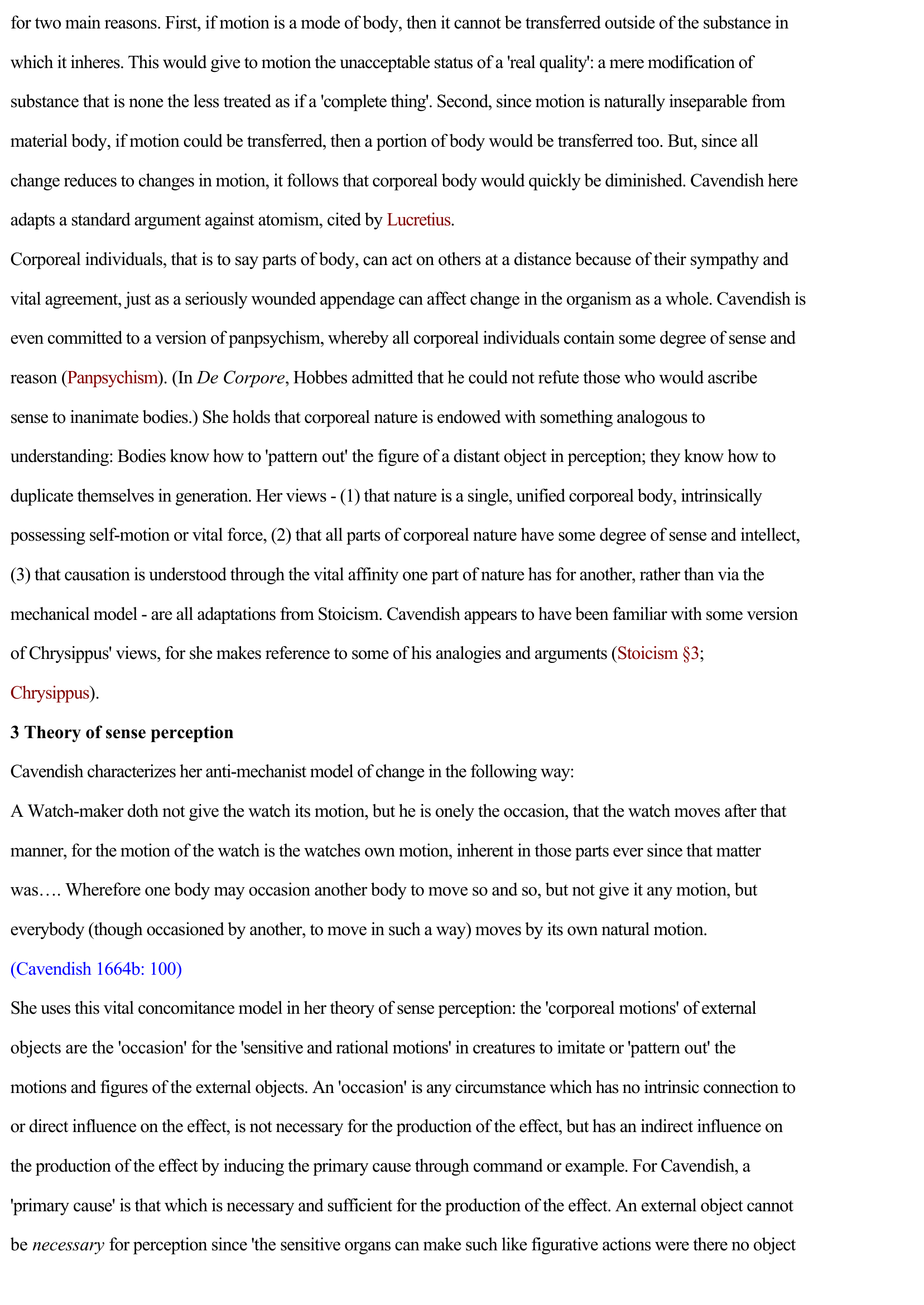Cavendish, Margaret Lucas
Publié le 22/02/2012

Extrait du document
«
for two main reasons.
First, if motion is a mode of body, then it cannot be transferred outside of the substance in
which it inheres.
This would give to motion the unacceptable status of a 'real quality' : a mere modification of
substance that is none the less treated as if a 'complete thing' .
Second, since motion is naturally inseparable from
material body, if motion could be transferred, then a portion of body would be transferred too.
But, since all
change reduces to changes in motion, it follows that corporeal body would quickly be diminished.
Cavendish here
adapts a standard argument against atomism, cited by Lucretius .
Corporeal individuals, that is to say parts of body, can act on others at a distance because of their sympathy and
vital agreement, just as a seriously wounded appendage can affect change in the organism as a whole.
Cavendish is
even committed to a version of panpsychism, whereby all corporeal individuals contain some degree of sense and
reason ( Panpsychism ).
(In De Corpore , Hobbes admitted that he could not refute those who would ascribe
sense to inanimate bodies.) She holds that corporeal nature is endowed with something analogous to
understanding: Bodies know how to 'pattern out' the figure of a distant object in perception; they know how to
duplicate themselves in generation.
Her views - (1) that nature is a single, unified corporeal body, intrinsically
possessing self-motion or vital force, (2) that all parts of corporeal nature have some degree of sense and intellect,
(3) that causation is understood through the vital affinity one part of nature has for another, rather than via the
mechanical model - are all adaptations from Stoicism.
Cavendish appears to have been familiar with some version
of Chrysippus' views, for she makes reference to some of his analogies and arguments ( Stoicism §3 ;
Chrysippus ).
3 Theory of sense perception
Cavendish characterizes her anti-mechanist model of change in the following way:
A Watch-maker doth not give the watch its motion, but he is onely the occasion, that the watch moves after that
manner, for the motion of the watch is the watches own motion, inherent in those parts ever since that matter
was… .
Wherefore one body may occasion another body to move so and so, but not give it any motion, but
everybody (though occasioned by another, to move in such a way) moves by its own natural motion.
(Cavendish 1664b: 100)
She uses this vital concomitance model in her theory of sense perception: the 'corporeal motions' of external
objects are the 'occasion' for the 'sensitive and rational motions' in creatures to imitate or 'pattern out' the
motions and figures of the external objects.
An 'occasion' is any circumstance which has no intrinsic connection to
or direct influence on the effect, is not necessary for the production of the effect, but has an indirect influence on
the production of the effect by inducing the primary cause through command or example.
For Cavendish, a
'primary cause' is that which is necessary and sufficient for the production of the effect.
An external object cannot
be necessary for perception since 'the sensitive organs can make such like figurative actions were there no object.
»
↓↓↓ APERÇU DU DOCUMENT ↓↓↓
Liens utiles
- UN ET L'AUTRE SEXE (L') [Male and Female]. Margaret Mead (résumé)
- NYMPHE AU CœUR FIDÈLE (La) Margaret Kennedy
- DIEU DES SORCIÈRES (Le) Margaret Alice Murray (résumé)
- Le personnage de LUCAS (El Tio)
- RECHERCHES SUR L’ÉLECTRICITÉ Henry Cavendish. Résumé et analyse

































